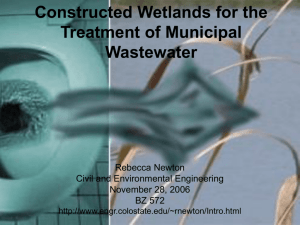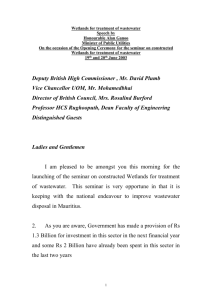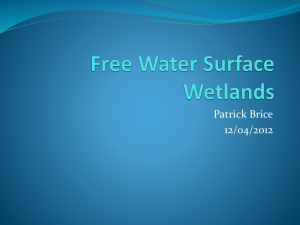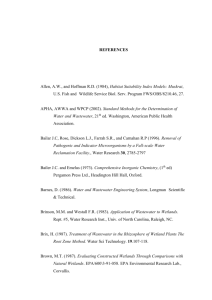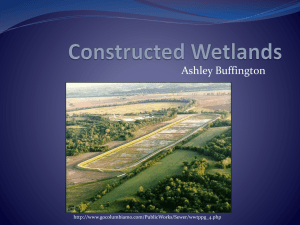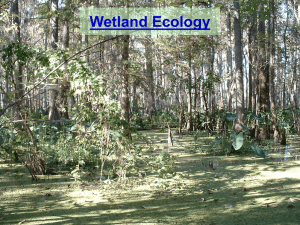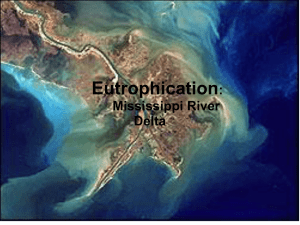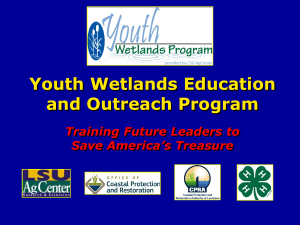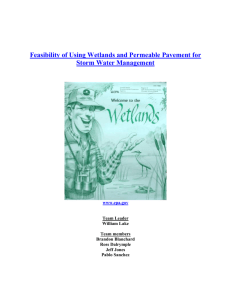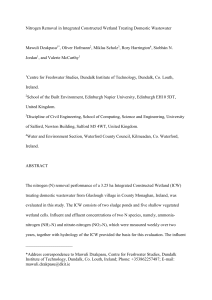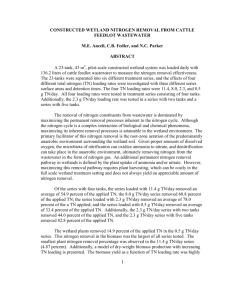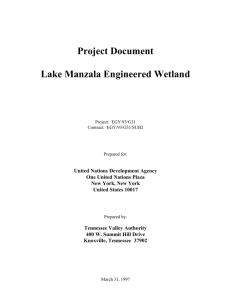Wetland-12
advertisement
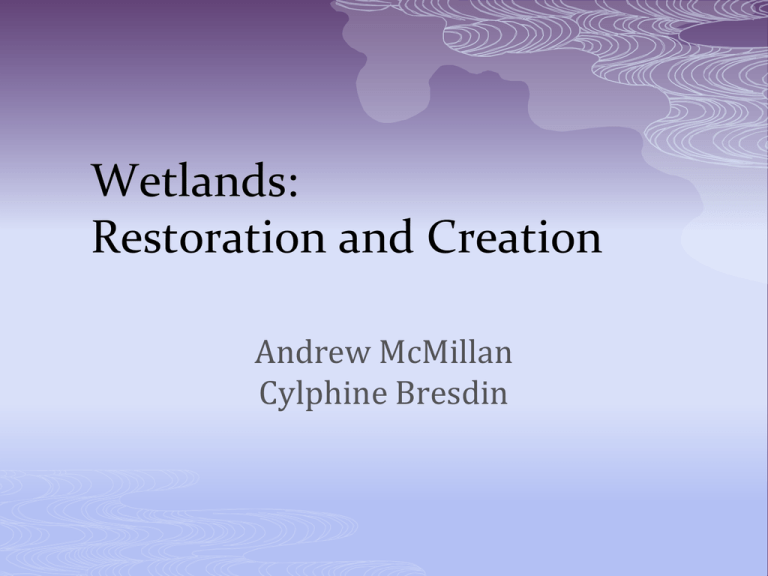
Wetlands: Restoration and Creation Andrew McMillan Cylphine Bresdin Two Approaches Mitigation Policy Restore Create Aesthetics Treatment Municipal Industrial Agricultural Storm Water WETLAND FUNCTIONS Multiple major Functions Catchment Slows and detours storm runoff City park WETLAND FUNCTIONS Multiple major Functions Catchment Slows and detours storm runoff Habitat Flora Fauna microorganisms Canal WETLAND FUNCTIONS Multiple major Functions Catchment Habitat Slows and detours storm runoff Flora Fauna microorganisms Filtration Pollutants and toxins Treatment Lagoon WETLAND FUNCTIONS Multiple major Functions Catchment Habitat Flora Fauna microorganisms Filtration Slows and detours storm runoff Pollutants and toxins Climatic effects Evens out the ambient temperature Golf course DEFINITIONS considered all wetland types MITIGATION- to make less harsh RESTORATION- return to prior existing condition CREATION- conversion (by human action) of suitable land CONSTRUCTED- a type of creation for the purpose of water treatment ENHANCEMENT- alters functional microhabitat relationships Definitions from text page 379 PRINCIPLES Self sufficient over time Habitat for aquatic and wildlife Habitat for (re)vegetation Surrounding environment Transition edge effects Micro organisms Geomorphology Hydrology Purpose Type POLICY Clean Water Act (CWA) Legal success Compensating for Wetland Losses Under the CWA http://www.nap.edu.catalog/10134.html No-net-loss Ecological success Location Self regulating hydrology succession Wetland bank compensatory Image from text page 380 RESTORATION Restore what has been lost due to human action Wetland Reserve Program 1990 Farm Bill Bottomland forest agriculture runoff Pre-filter Soil stabilization Habitat Image from text page 389 CREATION Legal responsibilities Hidden benefits Catchment Aesthetics Ecological Canyon Park Detention Pond Create new to replace lost AESTHETICS Created pond as landscape element CALA Building Underwood Garden Rain water harvesting and cycling Respite Education CONSTRUCTED Created pond as backyard waste water treatment Image from Oklahoma pamphlet on residential wetlands Local agency over-site Two Approaches Mitigation Policy Restore Create Aesthetics Treatment Municipal Industrial Agricultural Storm Water Wetland Functions Major Function: water filtration Water will slow trapping suspended solids by vegetation and settling out Pollutants are transformed to less soluble forms Taken up by plants or will become inactive Microorganisms thrive in wetland environment Microorganisms assist in transforming and removing pollutants from aquatic systems Wastewater Sources Wastewater Category Origin Frequency Description Municipal wastewater Residential & Commercial Continuous Urine, feces, paper, plastics, soaps, greases, household chemicals Industrial wastewater Industrial processes Continuousand leachates intermittent Diluted solution of biodegradable and non-degradable chemicals Agricultural wastewater Agricultural practices (slaughter houses, feedlots, chemicals) Continuousintermittent Diluted solution of biodegradable compounds Storm waters Runoff from urban, suburban, & rural areas Intermittent Diluted mixtures of mineral & organic solids, dissolved salts, nutrients, and trace constituents Municipal Wastewater Industrial Wastewater • Small percentage can discharge wastewaters for wetland systems for treatment – Requires pretreatment • Most contain toxic constituents at toxic conc. detrimental to wildlife & wetland treatment systems Agricultural Wastewater • Receives minimal treatment • Usually through lagoons • Treatment wetland systems are important for concentrated & pretreated agricultural wastewaters Storm Waters • Urban & suburban runoff are sometimes channelized to storm sewers to municipal treatment facilities • Most runoff is diverted to detention ponds for treatment • Nitrogen Removal • Nitrogen Removal • Phosphorous Removal • Nitrogen Removal • Phosphorous Removal • BOD Removal • Nitrogen Removal • Phosphorous Removal • BOD Removal • Metals Removal When to construct wetlands for treatment? • Affordable – Total costs: operation, maintenance, and depreciation are financially feasible • Operable – Can operation be sustained with local labor and support • Reliable – Will system be efficient at maintain effluent quality requirements consistently When to construct wetlands for treatment? • Affordable – Total costs: operation, maintenance, and depreciation are financially feasible • Operable – Can operation be sustained with local labor and support • Reliable – Will system be efficient at maintain effluent quality requirements consistently Free Water Surface & Subsurface Flow Systems Free Water Surface & Subsurface Flow Systems Free Water Surface & Subsurface Flow Systems Carolina Bays: Horry County, SC • Treatment plant will discharge 2.5 mgd of wastewater – Discharge 1in/week • Slowly released after primary and secondary treatment for tertiary treatment • 4-Bays; Alternate flow based upon flow rate and condition of bays Carolina Bays: Horry County, SC • Treatment plant will discharge 2.5 mgd of wastewater – Discharge 1in/week • Slowly released after primary and secondary treatment for tertiary treatment • 4-Bays; Alternate flow based upon flow rate and condition of bays Fort Deposit, AL • Rely majority on microorganisms to breakdown organic matter and nutrients • Cells constructed to simulate natural wetlands • System is designed for the retention time of wastewater to be ~30 days – Average decomposition rate varies upon season therefore retention time can be adjusted by effluent adjustment Fort Deposit, AL • Rely majority on microorganisms to breakdown organic matter and nutrients • Cells constructed to simulate natural wetlands • System is designed for the retention time of wastewater to be ~30 days – Average decomposition rate varies upon season therefore retention time can be adjusted by effluent adjustment Fort Deposit, AL • Rely majority on microorganisms to breakdown organic matter and nutrients • Cells constructed to simulate natural wetlands • System is designed for the retention time of wastewater to be ~30 days – Average decomposition rate varies upon season therefore retention time can be adjusted by effluent adjustment Conclusion • Wastewater treatment wetlands are not the solution to all water quality issues • Although thousands of constructed wetlands prove this process of treatment is an appropriate approach for a number of contaminants based upon the given situation • Several factors should be considered prior to designing and building Wetlands: Restoration and Creation Credits Constructed Wetlands and Aquatic Plant Systems for Municipal Wastewater Treatment, EPA Constructed Wetlands for Wastewater Treatment and Wildlife Habitat, EPA Treatment Wetlands, Kadlec & Knight Constructed Wetlands for Wastewater Treatment, Donald A Hammer Restoration, Creation, and Recovery of Wetlands, Mary E. Kentula, EPA Constructed Wetlands: Using Human Ingenuity, Natural Processes to Treat Water, Build Habitat, Joe Gelt Wetlands, Mitsch and Gosselink CWA report available from http://www.nap.edu.catalog/10 134.html


